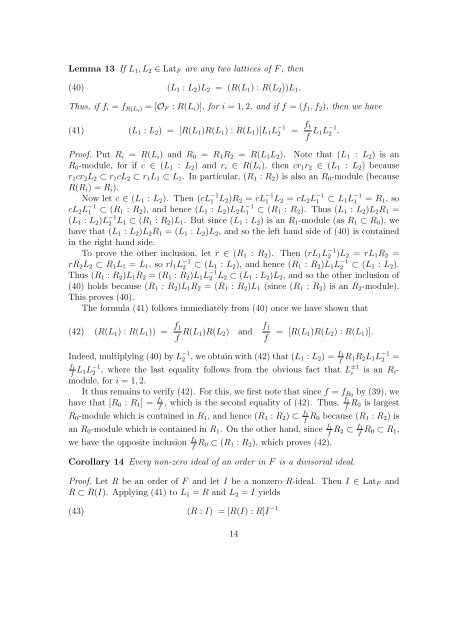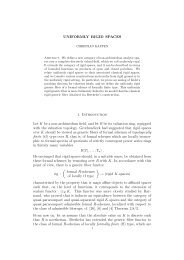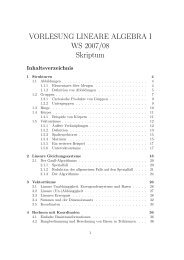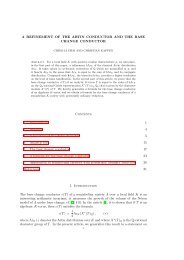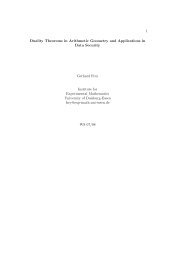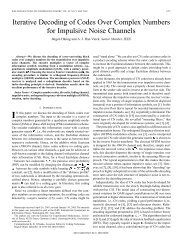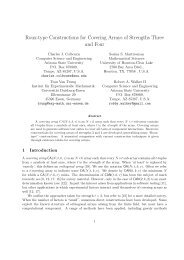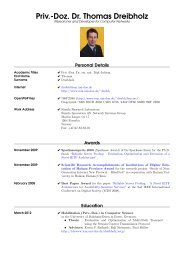Products of CM elliptic curves - Universität Duisburg-Essen
Products of CM elliptic curves - Universität Duisburg-Essen
Products of CM elliptic curves - Universität Duisburg-Essen
You also want an ePaper? Increase the reach of your titles
YUMPU automatically turns print PDFs into web optimized ePapers that Google loves.
Lemma 13 If L 1 , L 2 ∈ Lat F are any two lattices <strong>of</strong> F , then(40)(L 1 : L 2 )L 2 = (R(L 1 ) : R(L 2 ))L 1 .Thus, if f i = f R(Li ) = [O F : R(L i )], for i = 1, 2, and if f = (f 1 , f 2 ), then we have(41)(L 1 : L 2 ) = [R(L 1 )R(L 1 ) : R(L 1 )]L 1 L −12 = f 1f L 1L −12 .Pro<strong>of</strong>. Put R i = R(L i ) and R 0 = R 1 R 2 = R(L 1 L 2 ). Note that (L 1 : L 2 ) is anR 0 -module, for if c ∈ (L 1 : L 2 ) and r i ∈ R(L i ), then cr 1 r 2 ∈ (L 1 : L 2 ) becauser 1 cr 2 L 2 ⊂ r 1 cL 2 ⊂ r 1 L 1 ⊂ L 1 . In particular, (R 1 : R 2 ) is also an R 0 -module (becauseR(R i ) = R i ).Now let c ∈ (L 1 : L 2 ). Then (cL −11 L 2 )R 2 = cL −11 L 2 = cL 2 L −11 ⊂ L 1 L −11 = R 1 , socL 2 L −11 ⊂ (R 1 : R 2 ), and hence (L 1 : L 2 )L 2 L −11 ⊂ (R 1 : R 2 ). Thus (L 1 : L 2 )L 2 R 1 =(L 1 : L 2 )L −12 L 1 ⊂ (R 1 : R 2 )L 1 . But since (L 1 : L 2 ) is an R 1 -module (as R 1 ⊂ R 0 ), wehave that (L 1 : L 2 )L 2 R 1 = (L 1 : L 2 )L 2 , and so the left hand side <strong>of</strong> (40) is containedin the right hand side.To prove the other inclusion, let r ∈ (R 1 : R 2 ). Then (rL 1 L −12 )L 2 = rL 1 R 2 =rR 2 L 2 ⊂ R 1 L 1 = L 1 , so rl 1 L −12 ⊂ (L 1 : L 2 ), and hence (R 1 : R 2 )L 1 L −12 ⊂ (L 1 : L 2 ).Thus (R 1 : R 2 )L 1 R 2 = (R 1 : R 2 )L 1 L −12 L 2 ⊂ (L 1 : L 2 )L 2 , and so the other inclusion <strong>of</strong>(40) holds because (R 1 : R 2 )L 1 R 2 = (R 1 : R 2 )L 1 (since (R 1 : R 2 ) is an R 2 -module).This proves (40).The formula (41) follows immediately from (40) once we have shown that(42)(R(L 1 ) : R(L 1 )) = f 1f R(L 1)R(L 2 ) and f 1f = [R(L 1)R(L 2 ) : R(L 1 )].Indeed, multiplying (40) by L −12 , we obtain with (42) that (L 1 : L 2 ) = f 1R f 1R 2 L 1 L −12 =f 1L f 1L −12 , where the last equality follows from the obvious fact that L ±1i is an R i -module, for i = 1, 2.It thus remains to verify (42). For this, we first note that since f = f R0 by (39), wehave that [R 0 : R 1 ] = f 1f , which is the second equality <strong>of</strong> (42). Thus, f 1f R 0 is largestR 0 -module which is contained in R 1 , and hence (R 1 : R 2 ) ⊂ f 1f R 0 because (R 1 : R 2 ) isan R 0 -module which is contained in R 1 . On the other hand, since f 1f R 2 ⊂ f 1f R 0 ⊂ R 1 ,we have the opposite inclusion f 1f R 0 ⊂ (R 1 : R 2 ), which proves (42).Corollary 14 Every non-zero ideal <strong>of</strong> an order in F is a divisorial ideal.Pro<strong>of</strong>. Let R be an order <strong>of</strong> F and let I be a nonzero R-ideal. Then I ∈ Lat FR ⊂ R(I). Applying (41) to L 1 = R and L 2 = I yieldsand(43)(R : I) = [R(I) : R]I −114


